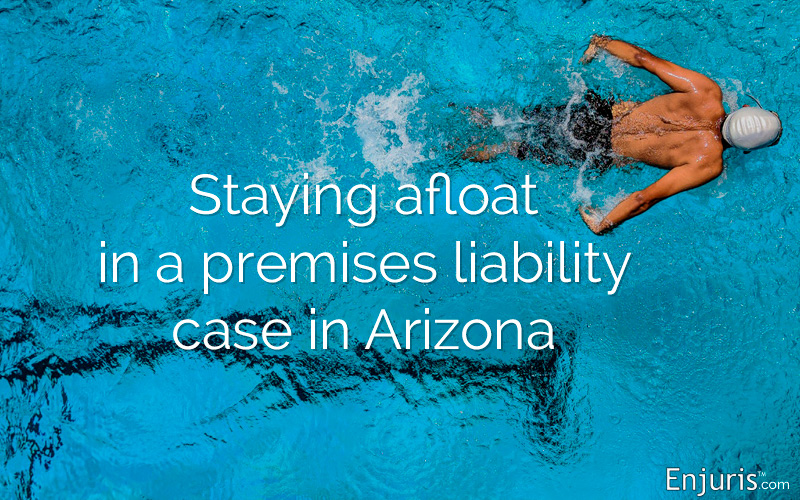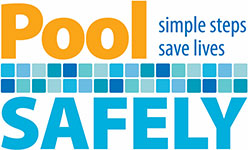
Learn who can be held responsible and how to recover damages
According to the Centers for Disease Control and Prevention (CDC), about 10 people die from unintentional drownings every day. Year-round warm weather and the presence of more than 300,000 residential swimming pools puts Arizona at particularly high risk for swimming pool accidents.
This article examines the prevalence of drowning accidents in Arizona, the laws governing swimming pools, the damages that may be recovered in the event of a drowning, and tips to prevent swimming pool accidents.
Swimming pool injuries and statistics
According to a report compiled by the Drowning Prevention Coalition of Arizona, the drowning death rate of Arizona’s preschoolers ranked 1st in the nation throughout the 1980’s. Over the least 6 years, Arizona ranks 4th among all states for drowning deaths among children ages 1-4, and such deaths occur at a rate nearly 2 times the national average.
Not all drownings are fatal, but more than 50% of drowning victims are treated in emergency departments. In the most recent year for which the data is available, 419 people were admitted to hospitals in Arizona for an incident of drowning or nonfatal drowning.
Nonfatal drowning injuries include:
- Severe brain damage
- Aspiration pneumonia
- Acute respiratory distress syndrome
- Hypothermia
It’s estimated that hospitals in Arizona charged over $10.3 million for care related to drownings in 2016.
Who’s at risk?
Nearly 80% of people who die from drownings are male. Children ages 1-4 are the most likely to drown. In addition, the following factors influence drowning risks:
- Lack of swimming ability
- New parents
- New owners of a pool
- Multiple children around the pool
- Underestimating the mobility of a toddler
- Lack of barriers
- Lack of close supervision
- Failure to wear life jacket
- Alcohol use
- Seizure disorders
Premises liability laws
The term “premises liability” refers to a set of rules that require property owners to take certain measures that ensure their property is safe for visitors. The measures they must take (or, to put it another way, the standard of care that they’re held to) depends on the status of the visitor.
Visitors to property, including swimming pools, are divided into 3 categories:
- Invitees: Someone who foreseeably enters the property even if they weren’t granted express permission (e.g., a customer entering a store)
- Licensees: Someone with express or implied permission to enter the property for non-business reasons (e.g., a friend invited over for a pool party)
- Trespassers: Someone not authorized to be on the property
The duties owed by the landowner to these different visitors can be described as follows:
- Invitee: Invitees are owed the highest degree of care. Landowners must keep the property reasonably safe and warn of dangerous conditions.
- Licensee: The landowner must warn the licensee of dangerous conditions that the landowner knows about and the licensee is not likely to discover.
- Trespasser: Landowners don’t owe trespassers any duty of care unless the trespasser is a child. If the trespasser is a child, the attractive nuisance doctrine applies and the landowner must exercise reasonable care to avoid a reasonably foreseeable risk of harm to children caused by artificial conditions that might be attractive to children (such as a swimming pool).
Just like with any other negligence claim, once the duty owed is determined, the injured person must prove that:
- The landowner breached the duty owed,
- The breach caused the harm, and
- The injured person was in fact harmed.
So what does this all mean?
If a landowner leaves their pool inadequately protected or unsupervised, they will likely be liable for any drowning injuries that occur — regardless of whether the injured person was an invitee, licensee, or trespasser.
Of course, other laws may apply and other parties may be held liable depending on the nature of the accident. For example, if an older swimmer holds a younger swimmer underwater, the older swimmer may be guilty of battery. If a pool pump malfunctions and injures a swimmer, the injured swimmer may be able to file a product liability claim against the manufacturer of the defective pool pump.
Specific requirements for pool owners
In an effort to reduce the high number of injuries and deaths by drowning in Arizona, the legislature passed Arizona Revised Statute 36-1681, which requires pool owners to take certain safety measures when 1 or more children under the age of 6 live in their home.
For example, all pools with more than 18 inches of water must be enclosed by an enclosure that:
- Entirely encloses the pool area
- Is at least 5 feet high
- Has no openings (other than doors or gates) through which a spherical object 4 inches in diameter can pass
- Has no openings, handholds, or footholds accessible from the exterior that can be used to climb the barrier
- Is at least 20 inches from the water’s edge
If there’s a door or gate within the 5-foot fence, it must:
- Open outward from the pool
- Be self-closing and self-latching
- Have a latch on the pool side of the gate that is located at least 54 inches above the underlying ground
What about public pools?
Public and semi-public pools must meet certain requirements set forth in Title 9, Chapter 8, Article 8 of the Arizona Administrative Code and Title 18, Chapter 5, Article 2 of the Arizona Administrative Code.
These codes set forth a number of specific requirements dealing with (among other items):
- Posting requirements
- Maximum number of swimmers
- Water quality and disinfection standards
- Water circulation requirements
- Water depth requirements
- Diving prohibitions
- Lifeguard requirements
- Deck requirements
In addition, some counties have their own regulations that are stricter than the regulations set by the state of Arizona. Check your local and county websites to see the code regarding swimming pool safety.
Defenses to pool accidents
Regardless of whether a pool visitor is an invitee, licensee, or trespasser, certain risks such as slippery surfaces around the pool and the danger posed by diving from inappropriate places are considered so “open and obvious” that the owner won’t be held liable.
Similarly, when a swimmer is injured, the owner will look to establish that the swimmer caused the accident or was at least partially at fault for the accident.
Arizona operates under the law of pure comparative fault. This means that the injured person’s damages will be reduced in accordance with their degree of fault.
Swimming pool accident damages
In Arizona, a person injured by a pool accident can recover the following damages:
- Economic damages (such as medical expenses and lost wages)
- Noneconomic damages (such as pain and suffering)
- Punitive damages (so long as the defendant was grossly negligent or intentionally caused the harm)
- Wrongful death damages
In most cases, the injured person will recover economic damages and noneconomic damages. Punitive damages are rarely awarded, but may be available in extreme cases when the defendant was either grossly negligent or intentionally caused the accident.
In the event that a person drowns, the person’s family (e.g., spouse, child, parent/guardian) can file a wrongful death lawsuit. The family member will have to prove liability the same way the deceased would have had to prove liability had they survived. If the family member is successful, they can recover a “fair and just amount” based on the following factors:
- The financial dependency of the survivors of the deceased
- The future earnings of the deceased
- The cost of medical, funeral, and burial services
- The value of the emotional distress caused by the death
Keep in mind that almost all homeowners insurance policies provide coverage for swimming pool accidents, which increases your chances of recovery in the event that the landowner doesn’t have any money.
Statute of limitations
For most negligence, intentional tort, and wrongful death claims, the statute of limitations in Arizona is 2 years. However, if the claim is brought against a public entity or public employee (which might be the case if a public pool is owned and operated by the county), the statute of limitations is only 1 year and a notice of claim must be filed within 180 days of the injury.
How to prevent swimming pool accidents
The Arizona Department of Health Services has come up with a number of pool safety recommendations. These include:
- Never leave a child unattended in the pool or pool area.
- Because flotation devices and swimming lessons are not substitutes for supervision, a child should always be watched when in or around the pool area.
- CPR/CCR instructions and the 911 emergency number (or a local emergency number) should be posted in the pool area.
- A phone should be located in the pool area or easily accessible in case of an emergency.
- All residential pool owners should attend water rescue and CPR/CCR class.
- Lifesaving equipment should be easily accessible and stored in the pool area.
- All gate locks and latches should be checked regularly to insure they are working properly.
- All items that could be used to climb a pool barrier should be removed from around the barrier.
We hope these tips help you to own a pool or swim without worry. In the meantime, if you need to speak with an attorney, try the Enjuris Arizona law firm directory.
Pool Safely is a national public education campaign from the U.S. Consumer Product Safety Commission (CPSC). Learn more about how Enjuris and Pool Safely help make water play and summer fun safer for families!
See our guide Choosing a personal injury attorney.

